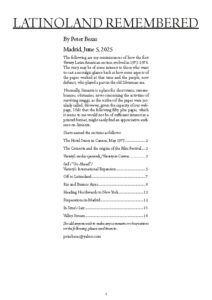Latinoland remembered
By Peter Besas
Madrid, June 5, 2025
The following are my reminiscences of how the first Variety Latin-American section evolved in 1975 -1976. The story may be of some interest to those who want to cast a nostalgic glance back at how some aspects of the paper worked at that time and the people, now defunct, who played a part in the old Silverman era.
Normally, Simesite is a place for short items, remembrances, obituaries, news concerning the activities of surviving muggs, as the scribes of the paper were jocularly called. However, given the capacity of our webpage, I felt that the following fifty plus pages, which it seems to me would not be of sufficient interest in a printed format, might easily find an appreciative audience on Simesite.
I have named the sections as follows (each section is a separate article on the site):
The Hotel Suisse in Cannes, May 1975
The Croisette and the origins of the Film Festival
Variety’s modus operandi,/Variety in Cannes
Syd’s “Go Ahead”/Variety’s International Expansion
Heading Northwards to New York
Should anyone wish to make any comments or observations on the following, please send them to:
If you’d rather download and read the article off line, it’s available here as a PDF:

